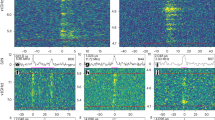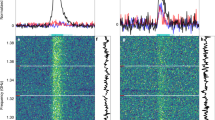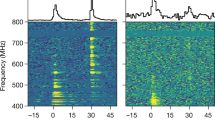Abstract
EARTH, Jupiter and Saturn are sources of intense but sporadic bursts of electromagnetic radiation which we call magnetospheric radio bursts (MRBs). The Earth's MRBs are observed at kilometric wavelengths, with a power flux spectral peak near 200–300 kHz, a bandwidth roughly half the peak frequency, and a high frequency cutoff near but below the electron gyrofrequency corresponding to the polar surface magnetic field. The Earth's MRBs last a few minutes. Jupiter's MRBs occur at decametric wavelengths, with a power flux spectral peak near 7–8 MHz, a bandwidth again roughly half the peak frequency, and a high frequency cutoff below the polar surface electron gyrofrequency; Jupiter's MRBs also last a few minutes. Saturn's MRBs are observed at hectometric wavelengths, with a power flux spectral peak near 1 MHz and a bandwidth of roughly half the peak frequency, and again last a few minutes. The similarities in the power flux spectra together with the burst occurrence patterns suggest a common physical origin for the MRBs of all three planets. Perhaps the common mechanism is noise amplification by field aligned currents since Gurnett1 has shown that Earth's MRBs are associated with bright auroral arcs which involve intense field aligned currents. Field aligned currents result from the interaction of the solar wind with the magnetosphere and should be a general feature of the interaction between the solar wind and a planetary magnetosphere (Vasyliunas2 and Kennel3). If MRBs are ultimately produced by the solar wind–magnetosphere interaction, their total radiated power might scale as the solar wind power input into the magnetosphere. Kaiser and Stone4 have suggested the frequency of emission scales as the polar magnetic field strength of the planet. Here, we scale the intensity of MRBs to the solar wind input and the frequency of emission to the polar field strength to estimate the possibility of detecting MRBs from Uranus and Neptune.
This is a preview of subscription content, access via your institution
Access options
Subscribe to this journal
Receive 51 print issues and online access
$199.00 per year
only $3.90 per issue
Buy this article
- Purchase on Springer Link
- Instant access to full article PDF
Prices may be subject to local taxes which are calculated during checkout
Similar content being viewed by others
References
Gurnett, D. A., J. geophys. Res., 79, 4227–4238 (1974).
Vasyliunas, V. M., in Earth's Magnetospheric Processes (edit. by McCormac, B. M.), 29–38 (Reidel, Dordrecht-Holland, 1972); in The Magnetospheres of Earth and Jupiter (edit. by Formisano, V.), 179–188 (Reidel, Dordrecht, Holland, 1975).
Kennel, C. F., Comm. Astrophys. Space Phys., 6, 71 (1975).
Kaiser, M. L., and Stone, R. G., Science, 189, 285–287 (1975).
Warwick, J. W., Astrophys. J., 137, 41–60 (1963).
Dulk, G. A., and Clark, T. A., Astrophys. J., 145, 945–948 (1966).
Kennel, C. F., Space Sci. Rev., 14, 511–533 (1973).
See for example Moroz, V. I., Physics of the Planets (Fizika Planet), 350 (‘Nauka’ Press, Moscow, NASA tech. transl., F-515, 1967).
Hill, T. W., and Michel, F. C., Rev. Geophys. Space Phys., 13, 967–974 (1975).
Brown, L. W., Astrophys. J. Lett., 194, L159–L162 (1974); ibid., 198, L89–L92 (1975).
Author information
Authors and Affiliations
Rights and permissions
About this article
Cite this article
KENNEL, C., MAGGS, J. Possibility of detecting magnetospheric radio bursts from Uranus and Neptune. Nature 261, 299–301 (1976). https://doi.org/10.1038/261299a0
Received:
Accepted:
Published:
Issue Date:
DOI: https://doi.org/10.1038/261299a0
This article is cited by
-
Predictions for Uranus from a radiometric Bode's law
Nature (1984)
Comments
By submitting a comment you agree to abide by our Terms and Community Guidelines. If you find something abusive or that does not comply with our terms or guidelines please flag it as inappropriate.



